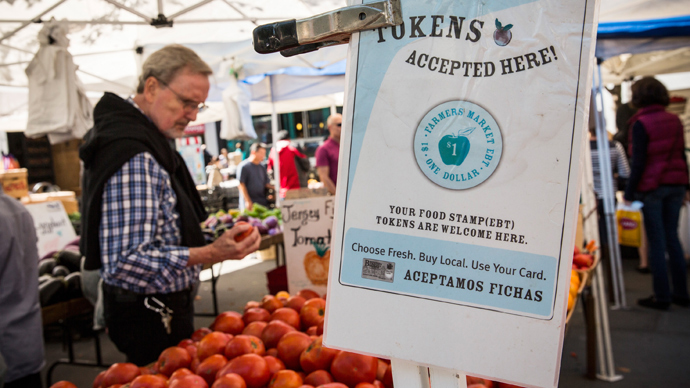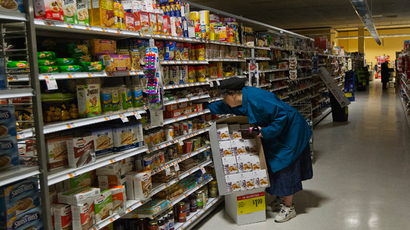Food bank CEO warns of riots over major food stamp cuts

The US food stamp system is to be reduced by $5 billion starting in November. The average benefit will shrink and the overall number of people receiving it will diminish by millions. The CEO of America’s largest food bank says the cuts will end in riots.
“Riots always begin typically the same way: when people cannot afford to eat food,” Margaret Purvis, president and CEO of the Food bank for New York City, told online news and entertainment site Salon.com
She added that families face the “daunting” prospect of losing a whole week’s worth of food every month.
Currently, the program costs
about $80 billion per year and provides food aid nearly 15 per
cent of all US households – over 45 million people.
A big automatic cut is expected on November 1, taking $5 billion from federal food-stamp spending over 2014. The benefit is set to shrink by 5 per cent.
One of the reasons for the reduction is the temporary expansion of the food-stamp program in 2009 as part of the Recovery Act.
Thus, the maximum monthly benefit for a household of four will drop by $36 a month, by $29 for a family of three, and by $20 for two people, according to a report published by the Center on Budget and Policy Priorities.
That bill spent $45.2 billion to increase monthly benefit levels to around $133.
Now, almost 45 million people get food stamps - compared to 26.3 million, or 8.7% of the population, in 2007.
However, it isn’t the last reduction the program will see over the next few months, with the Congress set to resume the negotiations over the five-year farm bill.
The Senate has so far approved the version of the farm bill that would make only minor changes to the food-stamp program, saving $4.5 billion over 10 years.
House Republicans, though, voted on a bill that takes $39 billion from the program over the decade, planning to remove 3,8 people from the program over 2014.
First, the Republicans are going to limit the benefits for able-bodied, childless adults aged 18 to 50, with the critics stating that employment options are scarce across the country, which will virtually let people starve.
Second, the House bill would restrict states' abilities to determine a person's eligibility for food stamps based in part on whether they qualify for other low-income benefits, The Washington Post reported.
This is called "categorical eligibility" and has generally allowed families just above the poverty line to get food stamps if they have unusually high housing costs or are facing other difficulties.
These changes are not set in stone because the Congressmen may not adopt them. However, the states may act on their own, putting some restrictions into practice.
In 2013, 44 states qualified for federal waivers that would allow more able-bodied adults to receive food stamps if unemployment in the area was particularly high.
Kansas already let its waiver expire at the start of October, a change that could affect as many as 20,000 people. Oklahoma passed a bill to add a similar work requirement to its food-stamp program. Ohio is also going to apply similar restrictions starting January 1, and Wisconsin will follow suit next July.














